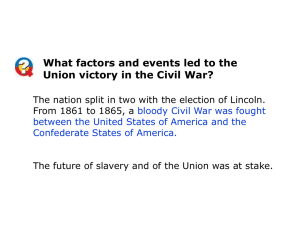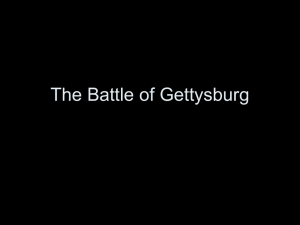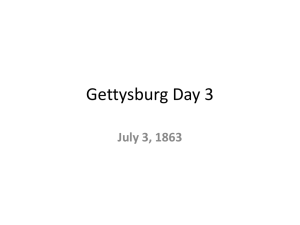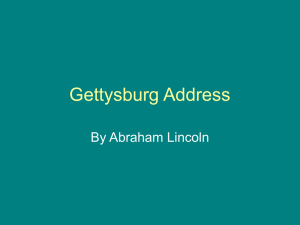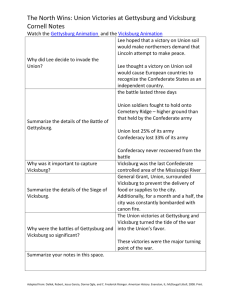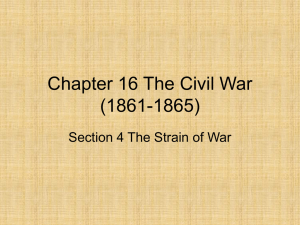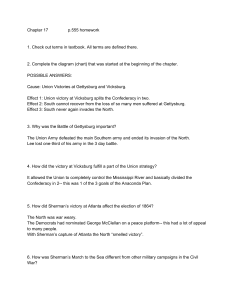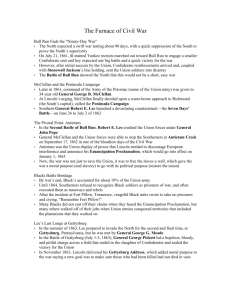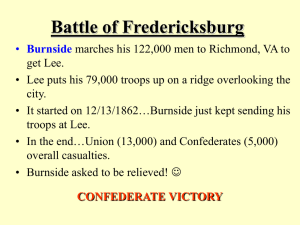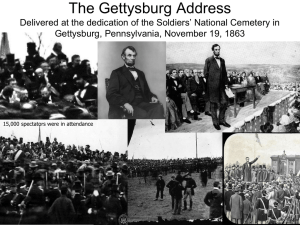The Turning Point
advertisement
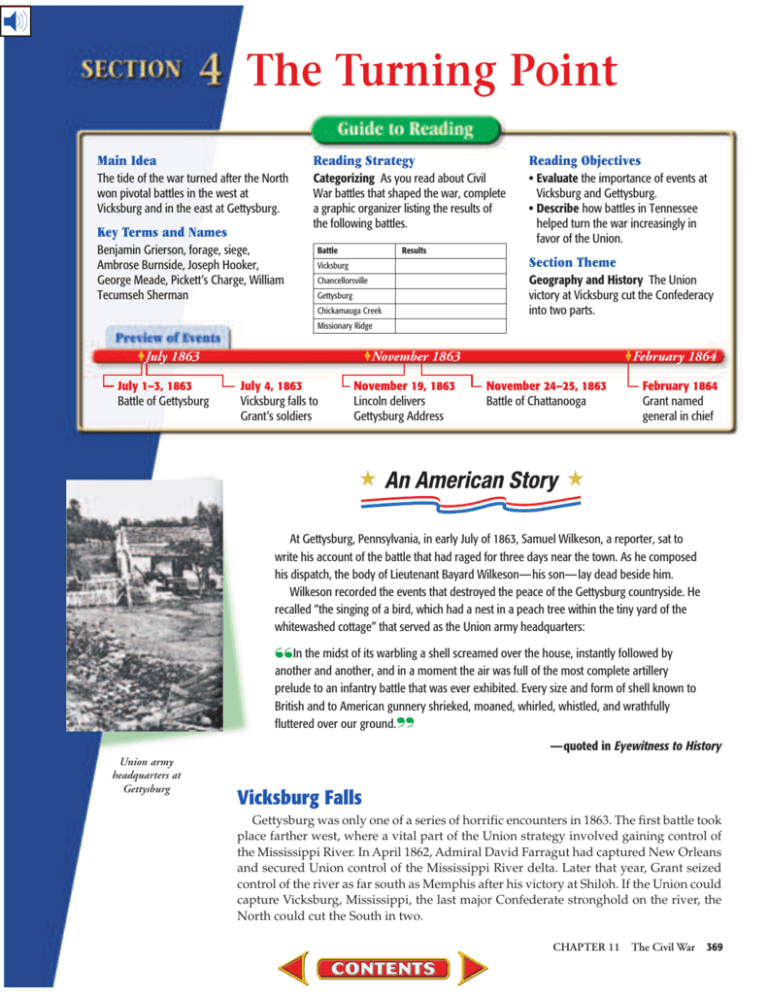
The Turning Point Main Idea Reading Strategy Reading Objectives The tide of the war turned after the North won pivotal battles in the west at Vicksburg and in the east at Gettysburg. Categorizing As you read about Civil War battles that shaped the war, complete a graphic organizer listing the results of the following battles. • Evaluate the importance of events at Vicksburg and Gettysburg. • Describe how battles in Tennessee helped turn the war increasingly in favor of the Union. Key Terms and Names Benjamin Grierson, forage, siege, Ambrose Burnside, Joseph Hooker, George Meade, Pickett’s Charge, William Tecumseh Sherman Battle Results Section Theme Vicksburg Geography and History The Union victory at Vicksburg cut the Confederacy into two parts. Chancellorsville Gettysburg Chickamauga Creek Missionary Ridge ✦July 1863 July 1–3, 1863 Battle of Gettysburg ✦November 1863 July 4, 1863 Vicksburg falls to Grant’s soldiers November 19, 1863 Lincoln delivers Gettysburg Address ✦February 1864 November 24–25, 1863 Battle of Chattanooga February 1864 Grant named general in chief At Gettysburg, Pennsylvania, in early July of 1863, Samuel Wilkeson, a reporter, sat to write his account of the battle that had raged for three days near the town. As he composed his dispatch, the body of Lieutenant Bayard Wilkeson—his son—lay dead beside him. Wilkeson recorded the events that destroyed the peace of the Gettysburg countryside. He recalled “the singing of a bird, which had a nest in a peach tree within the tiny yard of the whitewashed cottage” that served as the Union army headquarters: In the midst of its warbling a shell screamed over the house, instantly followed by “ another and another, and in a moment the air was full of the most complete artillery prelude to an infantry battle that was ever exhibited. Every size and form of shell known to British and to American gunnery shrieked, moaned, whirled, whistled, and wrathfully fluttered over our ground. ” Union army headquarters at Gettysburg —quoted in Eyewitness to History Vicksburg Falls Gettysburg was only one of a series of horrific encounters in 1863. The first battle took place farther west, where a vital part of the Union strategy involved gaining control of the Mississippi River. In April 1862, Admiral David Farragut had captured New Orleans and secured Union control of the Mississippi River delta. Later that year, Grant seized control of the river as far south as Memphis after his victory at Shiloh. If the Union could capture Vicksburg, Mississippi, the last major Confederate stronghold on the river, the North could cut the South in two. CHAPTER 11 The Civil War 369 Grierson’s Raid The city of Vicksburg was located on the east bank of the Mississippi River. At first Grant tried to approach the city from the north, but the land was too swampy, and the rivers in the area were covered with vegetation and blocked by trees. To get at Vicksburg, Grant decided to move his troops across the Mississippi to the west bank and then march south. Once he was past the city, he intended to cross back to the east bank of the river and attack the city from the south. To distract the Confederates while he carried out this difficult maneuver, Grant ordered Benjamin Grierson to take 1,700 troops on a cavalry raid through Mississippi. Grierson’s forces traveled 600 miles (965 km) in two weeks, tearing up railroads, burning depots, and fighting skirmishes. His raid distracted the Confederate forces defending Vicksburg and enabled Grant to move his troops south of the city. The Siege of Vicksburg After returning to the east bank of the Mississippi, Grant embarked on a daring march east, ordering his troops to live off the country. Foraging— or searching and raiding for food—as they marched, Grant’s troops headed east into Mississippi. They captured the town of Jackson before turning back west toward Vicksburg. Grant’s troops marched an astonishing 180 miles (290 km) in 17 days, fought 5 battles, and inflicted 7,200 casualties on the Confederates. The march ended by driving the Confederate forces back into their defenses at Vicksburg. In May 1863, Grant launched two assaults on Vicksburg, but the city’s defenders repulsed both attacks and inflicted high casualties. Grant decided that the only way to take the city was to put it under siege—to cut off its food and supplies and bombard the city until its defenders gave up. On July 4, 1863, with his troops starving, the Confederate commander at Vicksburg surrendered. The Union victory had cut the Confederacy in two. Reading Check Explaining Why did President Lincoln want the Union army to capture Vicksburg? The Road to Gettysburg Shortly after McClellan’s victory at Antietam, Lincoln became frustrated with the general. At Antietam, McClellan could have destroyed Lee’s army, but he let the Confederates slip away. He then moved so slowly after the battle that Lee was able to recover from his defeat at Antietam and block McClellan’s advance on Richmond. On November 7, 1862, Lincoln fired McClellan and gave command of the army to General Ambrose Burnside. Lincoln wanted a general who was not intimidated by Lee’s reputation. He urged Burnside to push south into Virginia and destroy Lee’s army. Lincoln did not know that the turning point in the east would come not in Virginia, but far to the north in Pennsylvania. Fredericksburg and Chancellorsville On December 13, 1862, Burnside ordered a series of bloody assaults against Lee’s troops entrenched in the hills south of Fredericksburg, Virginia. The Union troops suffered more than 12,000 casualties, more than twice as many as the Confederates. Distressed by the defeat and faced with complaints about Burnside from other officers, Lincoln replaced him with General Joseph Hooker. Hooker devised a plan to get at Lee’s troops on the hills near Fredericksburg. First, he left a large part of his army at Fredericksburg to keep Lee’s troops from moving. He then took the rest of the army History Vicksburg Besieged Union troops used this house as a headquarters during the siege of Vicksburg. Nearby are Union trenches and the opening to a tunnel being dug under Confederate lines. For how long was the city of Vicksburg under siege by Grant’s Union forces? west to circle around behind Lee’s troops and attack them from the rear. Realizing what was going on, Lee also divided his forces. He too left a small force at Fredericksburg and headed west with most of his troops to stop Hooker. On May 2, 1863, Lee’s troops attacked Hooker’s forces in dense woods known as the Wilderness near the town of Chancellorsville, Virginia. Although outnumbered two to one, Lee aggressively divided his forces and repeatedly defeated the Union troops. On May 5, Hooker decided to retreat. TURNING POINT The Battle of Gettysburg Having weakened Union forces at Chancellorsville, Lee wanted to launch another invasion of the North. In June 1863 Lee marched into Pennsylvania, where his troops seized livestock, food, and clothing. After Hooker failed to stop Lee, Lincoln removed him from command and appointed General George Meade as his replacement. Meade immediately headed north to intercept Lee. At the end of June, as Lee’s army foraged in the Pennsylvania countryside, some of his troops headed into the town of Gettysburg, hoping to seize a supply of shoes. When they arrived near the town, they encountered Union cavalry. On July 1, 1863, the Confederates pushed the Union troops out of the town into the hills to the south. At the same time, the main forces of both armies hurried to the scene of the fighting. (See pages 374–375.) On July 2 Lee attacked, but the Union troops held their ground. The following day, Lee ordered nearly 15,000 men under the command of General George E. Pickett and General A.P. Hill to make a massive assault. The attack became known as Pickett’s Charge. As the mile-wide line of Confederate troops marched across open farmland toward Cemetery Ridge where Union forces stood, Union cannons and guns opened fire, inflicting 7,000 casualties in a less than half an hour of fighting. Soldiers like Lieutenant Jesse Bowman Young, who survived Gettysburg, later recalled the deafening gunfire and horrifying bloodshed of the final assault: The caisson [ammunition chest] was set on fire, “ and in a moment with all its stock of ammunition, it exploded. . . . [T]here flashed for a single instant against the sky the sight of wheels, limbs of horses and of men, pieces of timber, and scores of exploding shells, all inextricably interwoven into a spectacle of horror. . . . Then the smoke covered the scene. . . . ” —quoted in Voices of the Civil War Bridging the Rappahannock Union troops build a pontoon bridge across the river in preparation for the assault on Confederate forces at Fredericksburg. The battle was a decisive Southern victory. Aftermath of the Battle Less than 5,000 Confederate troops made it up the ridge, and Union troops overwhelmed those who did. Lee quickly rallied his troops, withdrew from Gettysburg on a rainy July 4, and retreated to Virginia. At Gettysburg the Union suffered 23,000 casualties, but the South lost an estimated 28,000 troops, over one-third of Lee’s entire force. The disaster at Gettysburg proved to be the turning point of the war. The Union’s victory strengthened the Republicans politically and ensured that the British would not recognize the Confederacy. For the rest of the war, Lee’s forces remained on the defensive, slowly giving ground to the Union army. The Gettysburg Address In November 1863, Lincoln came to Gettysburg to dedicate a portion of the battlefield as a military cemetery. His speech—the Gettysburg HISTORY Address—became one of the best-known orations in Student Web American history. Lincoln Activity Visit the reminded his listeners that American Vision Web the nation was “conceived site at tav.glencoe.com in liberty, and dedicated to and click on Student the proposition that all Web Activities— men are created equal.” Chapter 11 for an He explained that the war activity on the Civil was not a battle between War. regions but a fight for freedom: CHAPTER 11 The Civil War 371 in History Ulysses S. Grant Robert E. Lee 1822–1885 Before his victories in Kentucky and Tennessee, Ulysses S. Grant had been a mediocre West Point cadet, a failed businessperson, and an undistinguished army officer. More than any other Union commander, however, Grant changed the strategy—and the outcome—of the Civil War. Grant’s restless urge for offensive fighting and his insistence on “unconditional surrender” at Fort Donelson convinced Lincoln to place the general in command of all the Union troops in 1864. Lincoln’s confidence was not misplaced. Despite mounting casualties and accusations that he was a “butcher,” Grant pushed relentlessly until he finally accepted Lee’s surrender at Appomattox, Virginia. The Union’s enthusiasm for its victorious general made Grant a two-term president after the war, although scandals in his administration marred his reputation. The Civil War had been the high point of Grant’s life, the challenge that brought out his best qualities. More than any monument or memorial—including Grant’s Tomb, in New York City—Lincoln’s defense of his embattled general during the war sums up Grant’s character and achievement: “I can’t spare this man; he fights.” 1807–1870 The son of a distinguished—though not wealthy—Virginia family, Robert E. Lee was raised in the socially exclusive world of the aristocratic South. From the beginning, he seemed marked by fate for brilliant success. At West Point he excelled in both his studies and his social life, impressing teachers and fellow cadets with his talent and good nature. As an army officer in the war with Mexico, he performed with brilliance and courage. Offered command of the Union troops at the beginning of the Civil War, Lee refused, unable to oppose his fellow Virginians. He later commanded the army of Northern Virginia. A hero to Southerners during the war, Lee felt a responsibility to set an example of Southern honor in defeat. His swearing of renewed allegiance to the United States after the war inspired thousands of former Confederate soldiers to follow his example. As president of Washington College in Virginia (later renamed Washington and Lee), Lee encouraged his students to put the war behind them and to behave as responsible citizens. Lee died at age 63. In his last moments, he seemed to give orders to his troops, and then at last called out, “Strike the tent!” “It is . . . for us to be here dedicated to the great task remaining before us—that from these honored captured Chattanooga, they would control a major railroad running south to Atlanta. The way would be open for a Union advance into Georgia. dead we take increased devotion to that cause for which they gave the last full measure of devotion; that we here highly resolve that these dead shall not have died in vain; that this nation, under God, shall have a new birth of freedom; and that the government of the people, by the people, and for the people, shall not perish from the earth. ” —from the Gettysburg Address ; (See page 1072 for more information on the Gettysburg Address.) Reading Check Summarizing What was the result Chickamauga During the summer of 1863, Union general William Rosecrans outmaneuvered General Braxton Bragg. In early September, he forced the Confederates to evacuate Chattanooga without a fight. Bragg did not retreat far, however. When Rosecrans advanced into Georgia, Bragg launched an assault against him at Chickamauga Creek on September 19, 1863. Bragg soon smashed through part of the Union defenses, and Rosecrans ordered his troops to fall back to Chattanooga, where he found himself almost completely surrounded by Bragg’s forces. of Pickett’s Charge? The Battle of Chattanooga Grant Secures Tennessee After the Union’s major victories at Vicksburg and Gettysburg, fierce fighting erupted in Tennessee near Chattanooga. Chattanooga was a vital railroad junction. Both sides knew that if the Union forces 372 CHAPTER 11 The Civil War In an effort to save the Union forces in Chattanooga, Lincoln decided to send some of Meade’s forces to help Rosecrans. Dozens of trains were assembled, and 11 days later, 20,000 men with their artillery, horses, and equipment arrived near Chattanooga after travelling more than 1,200 miles (1,930 km). Lincoln also decided to reorganize the military leadership in the west, and he placed Grant in overall command. Grant then hurried to Chattanooga to take charge of the coming battle. In late November, he ordered his troops to attack Confederate positions on Lookout Mountain. Charging uphill through swirling fog, the Union forces quickly drove the Southern troops off the mountain. Confederates retreating from Lookout Mountain hurried to join the Southern forces at Missionary Ridge east of Chattanooga. The Confederates were outnumbered, but they awaited a Union attack, secure on a high rugged position just as the Union troops had been at Cemetery Ridge near Gettysburg. Grant did not intend to storm Missionary Ridge. He believed an all-out assault would be suicidal. Instead he ordered General William Tecumseh Sherman to attack Confederate positions on the north end of the ridge. When Sherman failed to break through, Grant ordered 23,000 men under General George Thomas to launch a limited attack against the Confederates in front of Missionary Ridge as a diversion. To Grant’s astonishment, Thomas’s troops overran the Confederate trenches and charged up the steep slope of Missionary Ridge itself. “They shouted ‘Chickamauga,’” one Confederate remembered, “as though the word itself were a weapon.” The rapid charge scattered the surprised Confederates, who retreated in panic, leaving Missionary Ridge—and Chattanooga—to the Union army. Grant Becomes General in Chief By the spring of 1864, Grant had accomplished two crucial objectives for the Union. His capture of Vicksburg had given the Union control of the Mississippi River, while his Checking for Understanding 1. Define: forage, siege. 2. Identify: Benjamin Grierson, Ambrose Burnside, Joseph Hooker, George Meade, Pickett’s Charge, William Tecumseh Sherman. 3. Explain why the Union victory at Gettysburg was so important. Reviewing Themes 4. Geography and History Why was capturing Vicksburg important for the Union? Gunpowder The cannon and rifle fire that echoed throughout the valleys of Tennessee during Grant’s campaign had become a familiar sound on the battlefields of the United States and the rest of the world by the mid-1800s. The key ingredient in these powerful weapons was gunpowder. Scholars believe that the Chinese invented this explosive mixture and were using it in fireworks and signals as early as the 900s. In 1304 the Arabs used the powder to develop the first gun. In the centuries that followed, numerous nations would develop and improve on the gun—which made all other weapons before it obsolete. For what peaceful purposes can gunpowder be used? victory at Chattanooga had secured eastern Tennessee and cleared the way for an invasion of Georgia. Lincoln rewarded Grant by appointing him general in chief of the Union forces and promoting him to lieutenant general, a rank no one had held since George Washington. When the president met Grant in March 1864, he told him, “I wish to express my satisfaction with what you have done. . . . The particulars of your plan I neither know nor seek to know.” The president had finally found a general he trusted to win the war. Reading Check Examining Why was capturing Chattanooga important for the Union? Critical Thinking 5. Analyzing What do you think might have been the outcome of the war if the Confederates had won the Battle of Gettysburg? Why do you think so? 6. Organizing Using a graphic organizer similar to the one below, list the results of the Battle of Gettysburg. Make sure you consider both the Union and the Confederacy. Battle of Gettysburg Analyzing Visuals 7. Examining Photographs Examine the photograph on page 370 of Vicksburg, Mississippi. From looking at the picture, what do you think life was like for troops during a seige? Why do you think the troops were trying to tunnel under Confederate lines? Writing About History 8. Descriptive Writing Take on the role of a Confederate soldier at the Battle of Gettysburg. Write a journal entry describing the battle and your feelings about the result of the battle. CHAPTER 11 The Civil War 373
